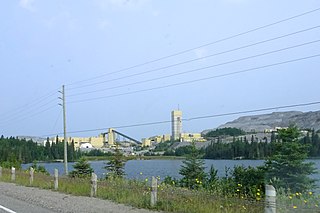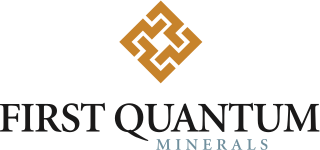Solwezi is a town in Zambia. It is the provincial capital of the mineral-rich North-Western Province. Solwezi is also the administrative capital of Solwezi District, one of the eleven districts in the North-Western Province.

Barrick Gold Corporation is a mining company that produces gold and copper with 16 operating sites in 13 countries. It is headquartered in Toronto, Ontario, Canada. It has mining operations in Argentina, Canada, Chile, Côte d'Ivoire, Democratic Republic of the Congo, Dominican Republic, Mali, Papua New Guinea, Saudi Arabia, Tanzania, the United States and Zambia. In 2023, it produced 4.05 million ounces of gold at all-in sustaining costs of $1,335/ounce and 420 million pounds of copper at all-in sustaining costs of $3.21/pound. As of 31 December 2023, the company had 77 million ounces of proven and probable gold reserves.

First Quantum Minerals is a Canadian-based mining and metals company whose principal activities include mineral exploration, development and mining. Its main product is copper, which accounts for 80% of revenues as of 2016.
NOVAGOLD is a Canadian company that is pursuing the development of the Donlin Gold mine in Alaska. Headquartered in Vancouver, the company is listed on the NYSE American and the Toronto Stock Exchange. The company was founded in Dartmouth, Nova Scotia, in 1984, to pursue exploration and development of mining properties. While the company bought and sold numerous exploration rights across North America, they have principally focused on four properties. They developed and operated the Murray Brook Mine in Nova Scotia from 1989 to 1992 and developed the Rock Creek Mine in Alaska but defaulted on financial obligations forcing it to close shortly after opening in 2008. They conducted exploration and development work on the Galore Creek mine in British Columbia between 2003 and 2018 but sold its interests. The development of the Donlin Gold mine has been pursued since the formation of a joint venture with Barrick Gold in 2012.

Mining in Papua New Guinea is an important part of the Papua New Guinea economy.

China Minmetals Corporation is a Chinese metals and mineral trading company headquartered in Beijing. It is a state-owned corporation under direct supervision of the State-owned Assets Supervision and Administration Commission (SASAC). China Minmetals is engaged in the production and trading of metals and minerals, including copper, aluminum, tungsten, tin, antimony, lead, zinc, and nickel.
Lundin Mining Corporation is a Canadian company that owns and operates mines in Sweden, United States, Chile, Portugal and Brazil that produce base metals such as copper, zinc, and nickel. Headquartered in Toronto, the company was founded by Adolf Lundin and operated by Lukas Lundin. While it was incorporated to pursue an interest in a diamond mine in Brazil, the company re-structured and raised funds to develop the Storliden mine in Sweden. It purchased the Swedish Zinkgruvan Mine from Rio Tinto and then merged with Arcon International Resources for its Galmoy Mine in Ireland and with Eurozinc for its Neves-Corvo mine in Portugal. The company subsequently purchased and operated the Eagle mine, Candelaria mine, and Chapada mine.

The mineral industry of Peru has played an important role in the nation's history and been integral to the country's economic growth for several decades. The industry has also contributed to environmental degradation and environmental injustice; and is a source of environmental conflicts that shape public debate on good governance and development.
There are different methods by which gold mining companies are ranked. One is by their annual production. Another is by their cash cost per ounce, that is, how much money it costs them to mine the gold. Since gold prices are the same everywhere, companies with lower costs per ounce make more profit. The most common method lists by market capitalization which considers the total value of capital holdings by that company. Also considered when comparing companies is their market capitalization per ounce of gold equivalent which takes the market value and total reserves and resources for each company as well as the price of gold into consideration. The figures for each company can be used to determine the value the stock market gives to each company's reserves on an ounce to ounce basis.
Franco-Nevada Corporation is a Toronto, Ontario, Canada-based, gold-focused royalty and streaming company with a diversified portfolio of cash-flow producing assets. It is traded on the Toronto Stock Exchange and New York Stock Exchange.
Turquoise Hill Resources was a Canadian mineral exploration and development company headquartered in Montreal, Quebec, and since December 2022, a wholly owned subsidiary of Rio Tinto Group. The company was called Ivanhoe Mines until August 2, 2012 when a financing agreement was completed with Rio Tinto. Rio Tinto acquired full ownership of Turquoise Hill in December 2022.
Wheaton Precious Metals Corp. is a Canadian multinational precious metals streaming company. It produces over 26 million ounces and sells over 29 million ounces of silver mined by other companies as a by-product of their main operations.
The Reko Diq Mine is a planned mining operation, located near Reko Diq town in Chagai District, Baluchistan, Pakistan. Reko Diq represents one of the largest copper and gold reserves in the world having estimated reserves of 5.9 billion tonnes of ore grading 0.41% copper and gold reserves amounting to 41.5 million oz, and a mining life of at least 40 years.
'Lumwana is a mining town located in Mwinilunga District, within the North-Western Province of Zambia.

Kerr-Sulphurets-Mitchell (KSM) is an active mine exploration project 65 km northwest of Stewart, British Columbia. The property is 100% owned by Toronto-based Seabridge Gold. Denver-based royalty company Royal Gold owns a 2% net smelter return royalty on the mine. Since May 2011, the project has also been called Kerr-Sulphurets-Mitchell-Iron Cap due to the addition of significant reserves from the Iron Cap region.
Kinsevere is an open pit mine and Heavy Media Separation plant with an electric arc furnace formerly operated by Anvil Mining, and now operated by Minerals and Metals Group. It is located 30 kilometres (19 mi) north of Lubumbashi, Katanga Province, Democratic Republic of Congo.

Metorex is a mining company based in Johannesburg, South Africa. It has assets in the Democratic Republic of the Congo (DRC), Zambia and elsewhere. A takeover bid by the Jinchuan Group of China valued the company at US$1.1 billion. Since January 2012, the company is a wholly owned subsidiary of Jinchuan Group.
The Lumwana mine is a large copper mine located in north-west Zambia in North-Western Province. Lumwana is owned by Barrick Gold and represents one of the largest copper reserves in Zambia and in the world having estimated 5.014 billion pounds of proven and probable copper reserves of ore grading 0.68% copper.






